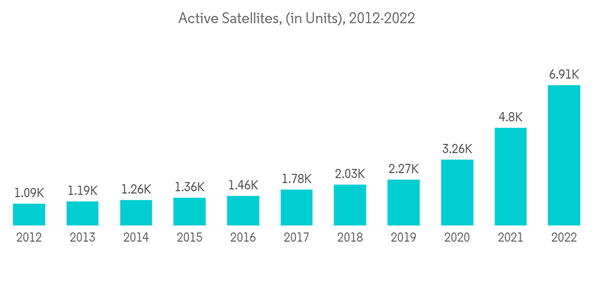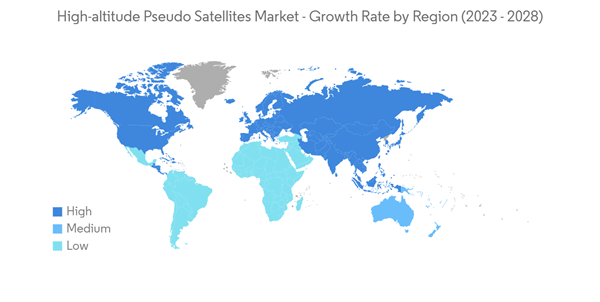The High-altitude Pseudo Satellites Market is valued at USD 0.85 billion in 2024 and is anticipated to reach USD 1.54 billion by 2029, registering a CAGR of 12.44% during the forecast period.
HAPS incorporates the best aspects of terrestrial and satellite-based communication systems. They eliminate the capacity and performance limitations of satellites by efficiently delivering voice, video, and broadband services at much more economical pricing vs. performance margins than conventional geostationary satellites. Hence, they are being increasingly adopted by telecommunication service providers to satiate the demand for high-capacity wireless services, especially last-mile delivery in remote areas with limited ground-based network coverage.
Though HAPS are more economical to manufacture and operate, the endurance of such platforms limits their effectiveness. In the case of HAPS platforms, such as unmanned aerial vehicles (UAVs), an electric propulsion system is integrated to enhance the endurance of the platform. It resulted in significant R&D investments towards the development of powerful battery systems and high-charge density solar panels to enhance the endurance of HAPS platforms, thereby making it more feasible for adoption by telecom and emergency service provider end-users.
HAPS operates at the stratospheric layer of the Earth's atmosphere, where the air density is around 7% compared to that at sea level. Hence, airborne systems face several operational challenges. For instance, since the lift generated is a direct function of air density, such platforms may also require a larger wing area (in the case of a fixed-wing UAV) or volume (in the case of an airship or balloon) to achieve sustained flight. To ensure compliance with the design's weight specifications, system designers must incorporate relatively advanced and lightweight materials for achieving weight optimization. For instance, Google is experimenting with a variety of materials for Project Loon. They envisioned using a combination of metalized mylar, Biaxially-oriented polyethylene terephthalate (BoPET), and highly flexible chloroprene for the Loon stratospheric balloon project. Similarly, Facebook used T700 carbon fiber for the construction of the prototype for Aquila. Ongoing development of HAPS models is also envisioned to foster the R&D towards lightweight materials during the forecast period.
Similarly, in March 2023, Thales received a USD 46 million contract for the EuroHAPS High-Altitude Platform Systems project. The project aims to design a stratospheric platform for a European consortium of eleven countries. Thales will provide the solar-powered airship Stratobus, which is a long-endurance, large-payload mission airship. The primary partners of EuroHAPS are CIRA (Italy), Elettronica (Italy), Leonardo (Italy), ONERA (France), CEA (France), INTA (Spain), ESG (Germany), and TAO(Germany).
Similarly, in January 2022, Sky Perfect JSAT, NTT, DOCOMO, and Airbus partnered to study and explore HAPS-based connectivity services as part of a space-based wireless connectivity ecosystem. NTT and SKY Perfect JSAT also partnered in the outer space ICT infrastructure project and developed a space-integrated computing network. Thus, the R&D efforts of the market players, coupled with favorable adoption trends in different Asian countries, are anticipated to drive the adoption of HAPS in the Asia-Pacific region in the forecast period.
This product will be delivered within 2 business days.
HAPS incorporates the best aspects of terrestrial and satellite-based communication systems. They eliminate the capacity and performance limitations of satellites by efficiently delivering voice, video, and broadband services at much more economical pricing vs. performance margins than conventional geostationary satellites. Hence, they are being increasingly adopted by telecommunication service providers to satiate the demand for high-capacity wireless services, especially last-mile delivery in remote areas with limited ground-based network coverage.
Though HAPS are more economical to manufacture and operate, the endurance of such platforms limits their effectiveness. In the case of HAPS platforms, such as unmanned aerial vehicles (UAVs), an electric propulsion system is integrated to enhance the endurance of the platform. It resulted in significant R&D investments towards the development of powerful battery systems and high-charge density solar panels to enhance the endurance of HAPS platforms, thereby making it more feasible for adoption by telecom and emergency service provider end-users.
HAPS operates at the stratospheric layer of the Earth's atmosphere, where the air density is around 7% compared to that at sea level. Hence, airborne systems face several operational challenges. For instance, since the lift generated is a direct function of air density, such platforms may also require a larger wing area (in the case of a fixed-wing UAV) or volume (in the case of an airship or balloon) to achieve sustained flight. To ensure compliance with the design's weight specifications, system designers must incorporate relatively advanced and lightweight materials for achieving weight optimization. For instance, Google is experimenting with a variety of materials for Project Loon. They envisioned using a combination of metalized mylar, Biaxially-oriented polyethylene terephthalate (BoPET), and highly flexible chloroprene for the Loon stratospheric balloon project. Similarly, Facebook used T700 carbon fiber for the construction of the prototype for Aquila. Ongoing development of HAPS models is also envisioned to foster the R&D towards lightweight materials during the forecast period.
High-Altitude Pseudo Satellites (HAPS) Market Trends
Airships Segment to Hold Largest Market Share in 2023
The airship segment is expected to contribute the largest market share in 2023. HAPS are effective tools for communication and surveillance as they operate from the Stratosphere, which is 20 km above the Earth's surface. HAPS uses the flexibility of airships with satellite endurance in missions. There are challenges to relying on unmanned balloons to provide such services, for instance, weather and limited onboard energy sources. Airships are preferred more over other platforms due to their capability to lift and power more payload. Airships can cover large areas quickly and effectively, including hard-to-reach locations. Other benefits of airships are low cost, flexibility, and ease of deployment. Airships are customized to carry specialized payloads such as communication equipment, sensors, and cameras. For instance, in August 2021, Sceye (US) completed a third test of the airship platform flight successfully in three months. The primary objectives of the airship test were to check beyond-line-of-sight command, attitude and automated pressure control, and reliable launch and ascent. Sceye airship can fly to 65,000 ft and is powered by solar energy.Similarly, in March 2023, Thales received a USD 46 million contract for the EuroHAPS High-Altitude Platform Systems project. The project aims to design a stratospheric platform for a European consortium of eleven countries. Thales will provide the solar-powered airship Stratobus, which is a long-endurance, large-payload mission airship. The primary partners of EuroHAPS are CIRA (Italy), Elettronica (Italy), Leonardo (Italy), ONERA (France), CEA (France), INTA (Spain), ESG (Germany), and TAO(Germany).
Asia-Pacific Region to Lead the Market in the Forecast Period
The adoption of HAPS is significantly high in developing countries in the Asia-Pacific region due to the absence of critical infrastructure to ensure telecommunication services in remote locations. HAPS platforms are instrumental in search and rescue (SAR) missions, disaster relief, environmental monitoring, and precision agriculture. Several governments in Asia-Pacific, such as India, permitted the pre-deployment testing of HAPS to critically analyze the feasibility of such systems in the countries. HAPS also efficiently delivers cost-effective broadband services and is viable as a suitable alternative infrastructure for the long-term provision of broadband access to fixed or mobile users. For instance, stratospheric balloons can stay afloat over their destined region for long periods of about 3-5 years and provide coverage over an area of around 500 km2. For instance, in March 2023, the National Aerospace Laboratories (NAL) launched India's first High Altitude Platform (HAP). High Altitude Platform includes a lot of applications, especially in communication like wireless access and emergency communication. The device can also help security agencies to keep a tight vigil at borders and prevent infiltrations and smuggling. The local administration can also use the device to check pollution and take stock of development activities in the area. The scientific agency informed that the full-fledged version of HAP will be ready in around three years.Similarly, in January 2022, Sky Perfect JSAT, NTT, DOCOMO, and Airbus partnered to study and explore HAPS-based connectivity services as part of a space-based wireless connectivity ecosystem. NTT and SKY Perfect JSAT also partnered in the outer space ICT infrastructure project and developed a space-integrated computing network. Thus, the R&D efforts of the market players, coupled with favorable adoption trends in different Asian countries, are anticipated to drive the adoption of HAPS in the Asia-Pacific region in the forecast period.
High-Altitude Pseudo Satellites (HAPS) Industry Overview
The high-altitude pseudo-satellites market is moderately consolidated and highly competitive, with players competing to gain the largest market share. Spectrum management challenges, endurance limitations of HAPS, and the cancellation of ongoing projects are envisioned to impede the growth of the market. Market players compete based on their in-house manufacturing capabilities, global footprint network, product offerings, R&D investments, and strong client base. AeroVironment, Inc., Airbus SE, Ball Corporation, Prismatic (BAE Systems plc), and THALES are the five major market players. They compete based on technological offerings and integration capabilities at a given price point. An increase in the high-altitude platform procurement rate is expected to fuel the market growth during the forecast period, thereby making it an ideal time to launch new products. Since the threat of new entrants is moderate, the competitive environment in the market is likely to intensify further due to an increase in product/service extensions and technological innovations. For instance, in February 2022, the Ministry of Defence (MoD) (India) inked a deal with aerospace startup NewSpace for the development of a High-Altitude Pseudo Satellite (HAPS). The initiative is part of the MoD's Innovations for Defence Excellence (iDEX) program. Backed by the Indian Army, the initiative will also see Hindustan Aeronautics Limited (HAL) come on board as the lead prototype development partner.Additional Benefits:
- The market estimate (ME) sheet in Excel format
- 3 months of analyst support
This product will be delivered within 2 business days.
Table of Contents
1 INTRODUCTION
4 MARKET DYNAMICS
5 MARKET SEGMENTATION
6 COMPETITIVE LANDSCAPE
Companies Mentioned (Partial List)
A selection of companies mentioned in this report includes, but is not limited to:
- AeroVironment, Inc.
- Airbus SE
- RosAeroSystems
- Prismatic (BAE Systems plc)
- THALES
- Ball Corporation
- Northrop Grumman Corporation
- Hawkeye Systems, Inc.
- Parrot Drone SAS
Methodology

LOADING...










